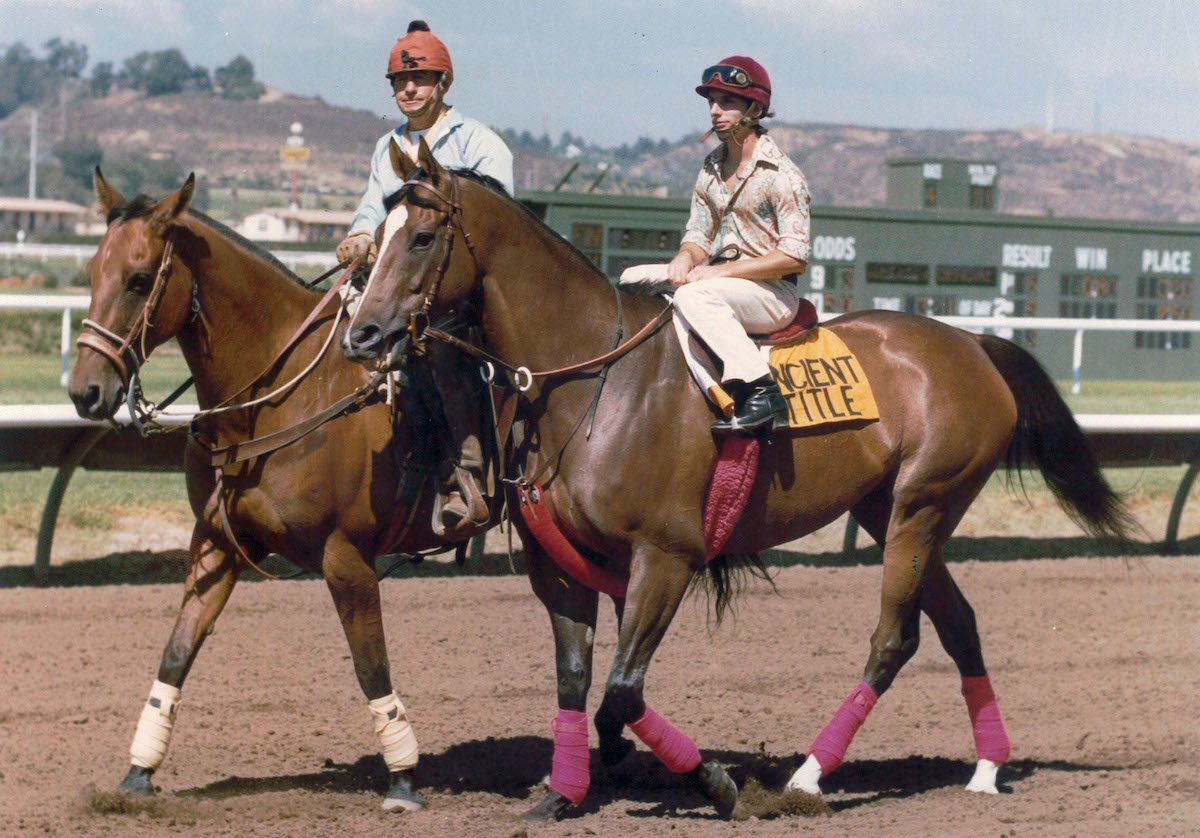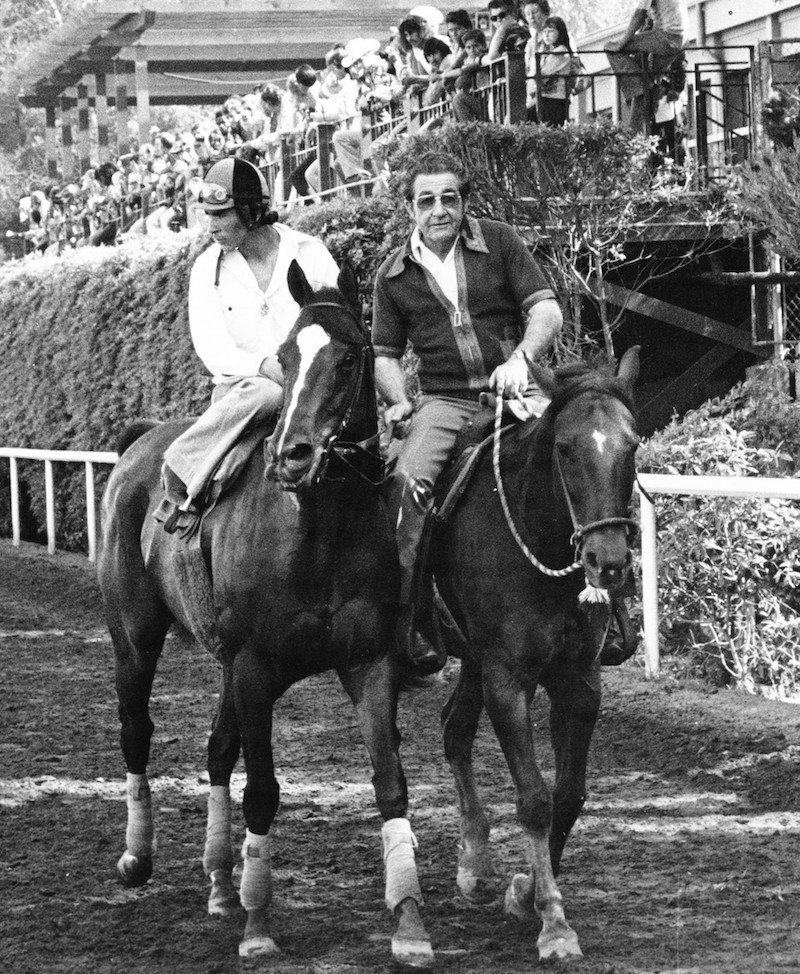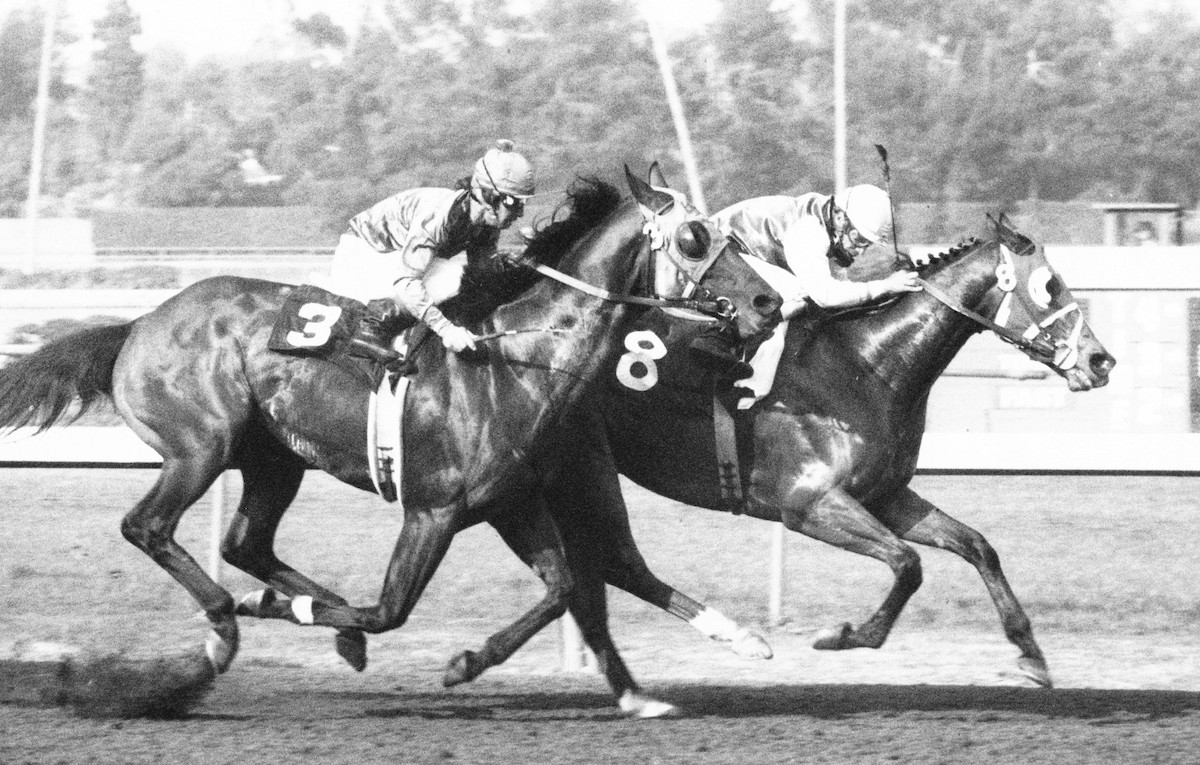
In the first of a new series recalling his personal favorites, Jay Hovdey looks back on the career of 1970s equine hero Ancient Title
My editor asked for a series of profiles featuring my favorite racehorses. I live to serve. However, I did warn him that the list would be long, because, like the song Sinatra sang first, I fall in love too easily. My list, my rules, so these will be horses I saw in person, in living color, and in the midst of great throngs. So it begins …
Early winter 1972. This reporter had recently survived 17 consecutive years of public education and was settling in to a dream job as third man on a three-man publicity team at Santa Anita Park, pretty much the equivalent of being assistant to the assistant footman at Buckingham Palace.
Five days into the belly of the beast, on the fifth day of the long meet, eight colts and geldings bred in the great state of California (pop. 20.8 million at the time) went postward in the male division of the California Breeders’ Champion Stakes at seven furlongs on the dirt. That was December 30, 1972.
What happened next was entirely expected. The winner, by nearly five lengths, was a young gun named Ancient Title. He was favored and rightfully so, having burned a similar 7f into the record books the previous October when his 1:20 4/5 over a tight Santa Anita strip in the Sunny Slope Stakes was the fastest ever recorded by a two-year-old at the distance.
These were the days, of course, before adjusted speed figures began to pour cold water on extravagant clockings. But still, it was pretty darn quick, and the race announced Ancient Title as a coming three-year-old with which to be reckoned, for at least as far as he could carry that speed.
I was not immediately enamored. There were way too many distractions for a wide-eyed, lifelong racing fan who was suddenly thrust inside the ropes. A few weeks later, on another Saturday afternoon, my boss Dan Smith choreographed a ‘Parade of Champions’, so dubbed without a whisper of exaggeration.
 Nose to tail they emerged from the Santa Anita stables to waltz in front of an applauding crowd – 1972 champion older mare Typecast, 1972 champion older horse Autobiography, 1972 champion turf horse Cougar II, 1972 champion three-year-old filly Susan’s Girl, 1972 champion sprinter Chou Croute – each one of them getting ready to run at the meet. Ancient Title would have to take a number.
Nose to tail they emerged from the Santa Anita stables to waltz in front of an applauding crowd – 1972 champion older mare Typecast, 1972 champion older horse Autobiography, 1972 champion turf horse Cougar II, 1972 champion three-year-old filly Susan’s Girl, 1972 champion sprinter Chou Croute – each one of them getting ready to run at the meet. Ancient Title would have to take a number.
‘A Thoroughbred for all seasons’
Before he was through, however – and you just knew that line was coming – Ancient Title had captured this racing fan heart and soul, along with a legion of followers who came to rely upon his abject honesty and varied flights of brilliance. For six rocking, rollercoaster seasons, from the age of Secretariat to the struggles of Alydar and Affirmed, Ancient Title was my go-to racehorse, a Thoroughbred for all seasons.
First, a light dusting of historical context. Whatever good vibes were floating around the North American breeding sheds in early 1969 should have been bottled and preserved for posterity. The covers must have been mighty, the gestations magical.
When the foals began to drop in 1970 – a total of 24,361 by the time they were finished – among them were seven future Hall of Famers, a European Horse of the Year, and a colt who became one of the foremost progenitors of the breed. Their names were Secretariat, Forego, Dahlia, Desert Vixen, Cafe Prince, La Prevoyante, Allez France, Mr. Prospector and Ancient Title.
Not a bad bunch, and Ancient Title outlasted them all, save Cafe Prince, a fellow Cal-bred who was still clearing fences for Jonathan Sheppard at the age of 10. By the time Ancient Title made the last of his 57 starts on August 19, 1978, Secretariat’s fourth crop had hit the ground and Forego had been retired for six weeks. Dahlia, that iron mare with 48 starts of her own, was about to turn loose of her first weanling in a Kentucky field.
True to his blue-collar roots, Ancient Title came from simple stock. His female family was pitifully thin on accomplishments, although his damsire, Bar Le Duc, was bred to be something special and might have been, were it not for chronic infirmities. He raced once and won, and his name, taken from the cathedral town that served as a playground for French royalty during the Renaissance, inspired thoughts of a title bequeathed in ancient times.
Hi Little Gal, Bar Le Duc’s daughter, was quick but did not last. She at least earned a breeding to Gummo, a promising young stallion by the tempestuous Fleet Nasrullah, whose first crop hit the ground out West in 1969. Gummo and Hi Little Gal were mated in the spring of 1969 at Three Rings Ranch in Beaumont, California, a farm town nestled against the foothills of the San Jacinto Mountains, about 80 miles due east of downtown Los Angeles.
An aristocratic blaze and anklet stockings
Ancient Title arrived on April 19, 1970, sporting an aristocratic blaze and anklet stockings behind. His coat would eventually come to be called dark bay or brown, in the official parlance, but he was always more medium brown than bay, complemented by a classic black mane and tail.
That mane and that tail later would famously be adorned with a collection of white and purple pom-poms to match the colors of the silks worn by his various jockeys. I watched those decorations delicately attached by his grooms, who served at Ancient Title’s sufferance. But on those racing days he was too keyed up to tolerate their attention, the pom-poms were discarded, and he rarely lost.
 The silks belonged to William and Ethel Kirkland, an older couple who could hardly believe their luck as small-time breeders. Bill Kirkland made his money as a paving contractor in the LA area, and goodness knows there was a lot of Southern California being paved. As their trainer they employed Keith Stucki, a former jockey and exercise rider who could claim Seabiscuit as one of his morning mounts way back when. Stucki, known for his flamboyant sports jackets at the races, had been around long enough to figure out early that Ancient Title was a once-in-a-lifetime horse.
The silks belonged to William and Ethel Kirkland, an older couple who could hardly believe their luck as small-time breeders. Bill Kirkland made his money as a paving contractor in the LA area, and goodness knows there was a lot of Southern California being paved. As their trainer they employed Keith Stucki, a former jockey and exercise rider who could claim Seabiscuit as one of his morning mounts way back when. Stucki, known for his flamboyant sports jackets at the races, had been around long enough to figure out early that Ancient Title was a once-in-a-lifetime horse.
The guy who knew it before anyone, however, was a 20-year-old hand at Three Rings whose job was breaking the dozens of yearlings that flowed through the ranch every year.
His name was Richard Mandella. Yes, that Richard Mandella. Let him tell it:
“One day the farm manager, Bill Foy, told me Keith Stucki was sending us 12 horses owned by a new client of his, Maribel Blum. They were all high-priced and well-bred. He told me to start them the next day along with Keith’s cheap homebred – the one by Gummo out of Hi Little Gal.
“About two weeks went by, and I hadn’t spoken to Bill about any of them,” Mandella went on. “He told me Stucki called and wanted to know what we thought of that group of yearlings he sent us. I said, ‘Tell him the cheap homebred is worth all those others and more.’ And I’d only galloped him one time on the track.”
Okay, so what was it about the raw yearling version of Ancient Title that inspired Mandella’s spark of Nostradamus prescience? “Me and one other boy had 50 yearlings a day, nine or ten months of the year,” Mandella said.
‘There was just something about him’
“I rode so many young ones that I just got a feel, and I was right a lot of the times. Ancient Title did everything perfect the first time he ever galloped. Changed leads perfect every time. And it wasn’t that alone. There was just something about him.”
Intangibles, by definition, cannot be put into words. Horsemen like Mandella train Thoroughbreds through instinct and intuition, not by a program. Half a century later, after a host of champions and a place in racing’s Hall of Fame, Mandella still can summon memories of the “cheap homebred” who hit all the right notes and stood out from the crowd.
Dr. Jack Robbins, who gelded such star runners as Native Diver and Bardstown, added Ancient Title to that list in 1972 as a two-year-old. The operation cooled his jets somewhat, but still he burned too hot as a three-year-old. His season ended on May 19, 1973, with a second at a mile on grass in the Will Rogers Handicap at Hollywood Park. That same day Secretariat won the Preakness.
Ancient Title was back to the races at the end of the year a different beast. He was beginning to muscle out handsomely, giving more staying power to his long legs and efficient stride. By then I tried to visit the Stucki barn as often as possible, and the trainer, with his gruff baritone and easy smile, was like the small town shop owner who had the Mona Lisa on display in the window. “Sure you can see Ancient Title. Go ahead. Just don’t get too close.”
Bear in mind, Stucki and his Cal-bred gelding were up against such powerhouse contemporaries as Charlie Whittingham, Ron McAnally, Robert Wheeler, Gary Jones and Tommy Doyle. But if that bothered Ancient Title, he hid it well.
In early 1974, he swept the series of races for four-year-olds that included the seven-furlong Malibu Stakes, the nine-furlong San Fernando Stakes, and the 10-furlong Charles H. Strub Stakes, named for Santa Anita’s founder. It was a rare and heralded feat. Round Table and Hillsdale had done it before Ancient Title, while Spectacular Bid and Precisionist did it after. The series no longer exists.
Good days and bad
Ancient Title had good days and bad, but there were so many times he took the breath away. He won seven times in seven races at 7f, all stakes, a remarkable record at a challenging distance that suited his ability to sprint with the rabbits and stay with the hounds.
The Strub Stakes, at a mile and a quarter, was not a fluke. Ancient Title proved himself at the American Classic distance more than once. In June 1975, while carrying topweight of 125lb, he ran away and hid from the opposition in the Hollywood Gold Cup. The following winter, Ancient Title was front and center again in the Santa Anita Handicap, losing by a desperate nose to the accomplished easterner, Royal Glint.
In the summer of 1977, the horse they thought would be nothing more than a nice sprinter humiliated a field of all-stars in the Del Mar Handicap, at 60 feet shy of a full ten furlongs. And then, just because he could, Ancient Title defied expectations to finish third in the Oak Tree Invitational, at a mile and a half on the Santa Anita turf. With Darrel McHargue aboard, he was beaten a neck and a nose by Crystal Water and Vigors, both winners of the Santa Anita Handicap.
 McHargue was one of 11 jockeys who rode Ancient Title. Several were aboard only briefly, including Angel Cordero, Don Pierce, Wayne Harris, Howard Grant, Juan Palomino and, at the end, Bill Shoemaker. Fernando Toro was at the wheel for nine rides and five of Ancient Title’s seven scores at 7f. Sandy Hawley was the man for 15 starts, including their landmark victory in the 1975 Whitney Handicap at Saratoga, while Laffit Pincay Jr. was attached for 17 races, including the Strub Stakes, the Hollywood Gold Cup, and Ancient Title’s third-place finish in the 1975 Marlboro Cup to champions Wajima and Forego.
McHargue was one of 11 jockeys who rode Ancient Title. Several were aboard only briefly, including Angel Cordero, Don Pierce, Wayne Harris, Howard Grant, Juan Palomino and, at the end, Bill Shoemaker. Fernando Toro was at the wheel for nine rides and five of Ancient Title’s seven scores at 7f. Sandy Hawley was the man for 15 starts, including their landmark victory in the 1975 Whitney Handicap at Saratoga, while Laffit Pincay Jr. was attached for 17 races, including the Strub Stakes, the Hollywood Gold Cup, and Ancient Title’s third-place finish in the 1975 Marlboro Cup to champions Wajima and Forego.
‘He was a good, good horse’
“He was a good, good horse,” Pincay said recently. “When he was at his best, he was very tough to beat. He was a free-running horse, and you couldn’t force him to do anything. He had to go on his own. If he wanted to lay third, just leave him there. If he wanted to be in front, fine. I never messed around with him,
“He was a very long horse,” Pincay continued. “You had to take a long rein with him and just nurse him along. Then when you asked him, he really tried.”
When Pincay fractured a collarbone at Hollywood Park in 1975, Hawley stepped in for the Whitney. As 1975 dawned, no horse trained in California had ever shipped in to win the race. The winners included 13 horses who were either in the Hall of Fame or on their way. Carrying topweight of 128lb, Ancient Title defeated Group Plan by a neck. A couple months later, Group Plan won the Jockey Club Gold Cup.
When we heard about the Whitney, back in California, the reaction was, “The Whitney? Really? Of course he did.” It was probably his Whitney that eventually landed Ancient Title in the Hall of Fame at the National Museum of Thoroughbred Racing in Saratoga Springs. His record of 24 wins and 20 placings in 57 starts looks good among the other geldings in the pantheon, and 20 of those victories came in stakes events. Ancient Title was elected by the Historical Review Committee in 2008, some 30 years after his final race.
“We loved him, but he never really was happy in retirement,” said Cincy Dollase, who owned Rio Vista Farm in Atascadero, California, with her husband, Wally.
By then, both William and Ethel Kirkland had died. On Stucki’s recommendation, their family decided to pension Ancient Title after he injured a tendon while running in the San Diego Handicap at Del Mar during the 1978 meet. He had returned from minor injuries in the past, and he had just won a six-furlong comeback race after a five-month break. But this time it was different and the Dollases welcomed him with open arms.
‘He just wanted to be treated like a racehorse’
“We turned him out with another gelding in a nice paddock with trees,” Cincy Dollase said. “He could look over at the mares and everything. But he hated it. He paced and paced and took it out on his buddy. So Wally brought him into a stall in the training barn, where he could watch the horses we were breaking go in and out. He just wanted to be treated like a racehorse. That’s all he ever knew.”
There were best-laid plans to visit Ancient Title at Rio Vista, but they were easy to postpone, and he figured to be there for a long time. Then, on September 1, 1981, word came that he had suffered a severe bout of colic that could not be relieved by an operation. He lived just 11 years, which was not a lot, but more than enough to make an everlasting mark on the game. And me.
“We buried him in the grassy center of the training barn, and had a bronze marker made for the site,” Dollase said. Not long after that, the Dollases moved to the LA area, where Wally commenced a successful training career. Wally Dollase died in the fall of 2015, while Stucki passed away six months later, at 96.
“I was in Atascadero this past summer visiting family,” said Cincy, who now lives in Kentucky. “I went out to Rio Vista, and it’s all wine now – grape vines everywhere, the barn gone, the training track gone. It’s so sad. I could only wonder what was covering over Ancient Title, and if he would be remembered.”
• Visit the National Museum of Racing and Hall of Fame website
Jay Hovdey: Introducing the untold stories of the backstretch
Racetrack photographer Lou Hodges: Capturing the moment – 100,000 times and counting
Charles Hayward: Change the culture – or risk going the way of the circus and dog racing
View the latest TRC Global Rankings for horses / jockeys / trainers / sires


